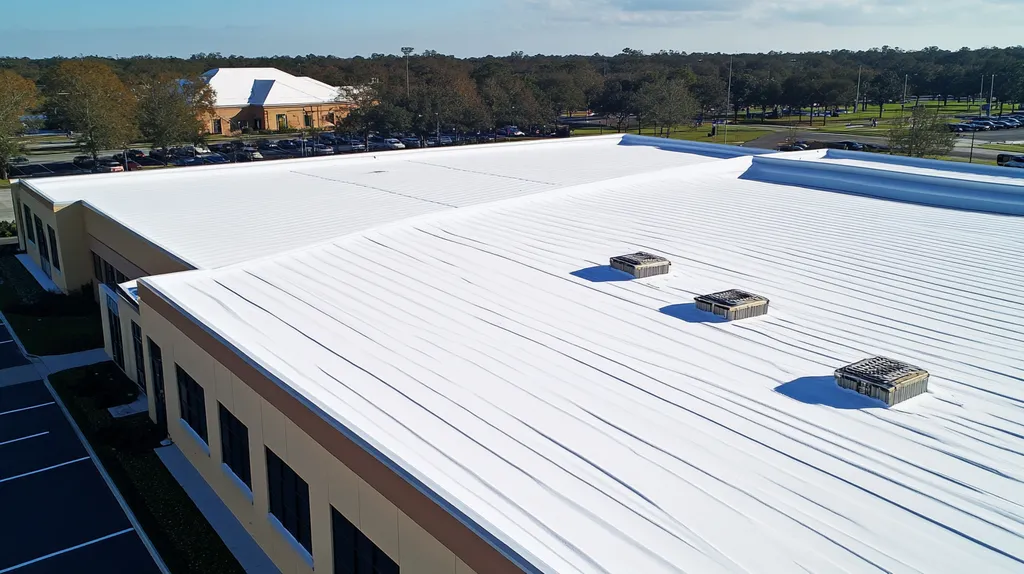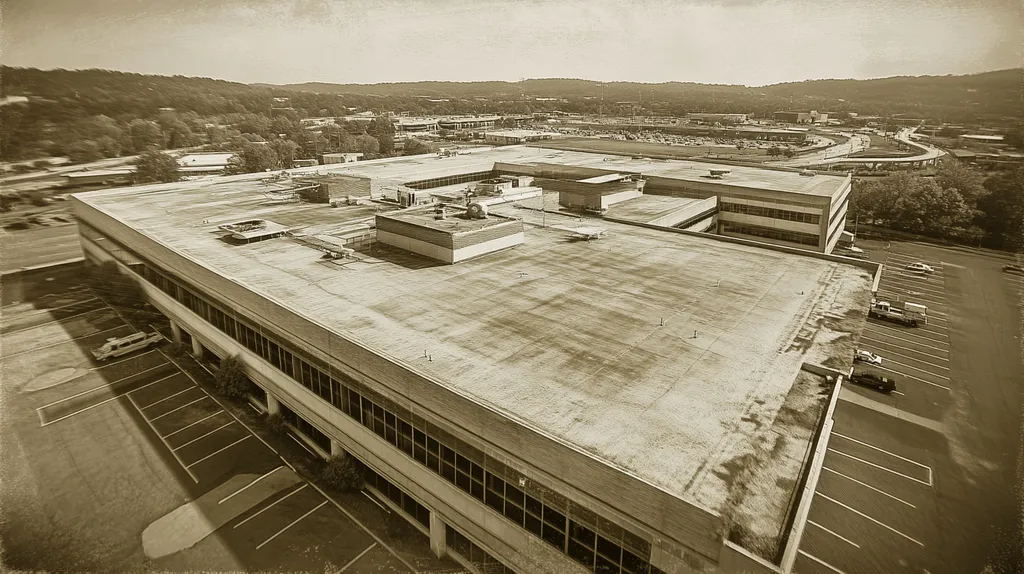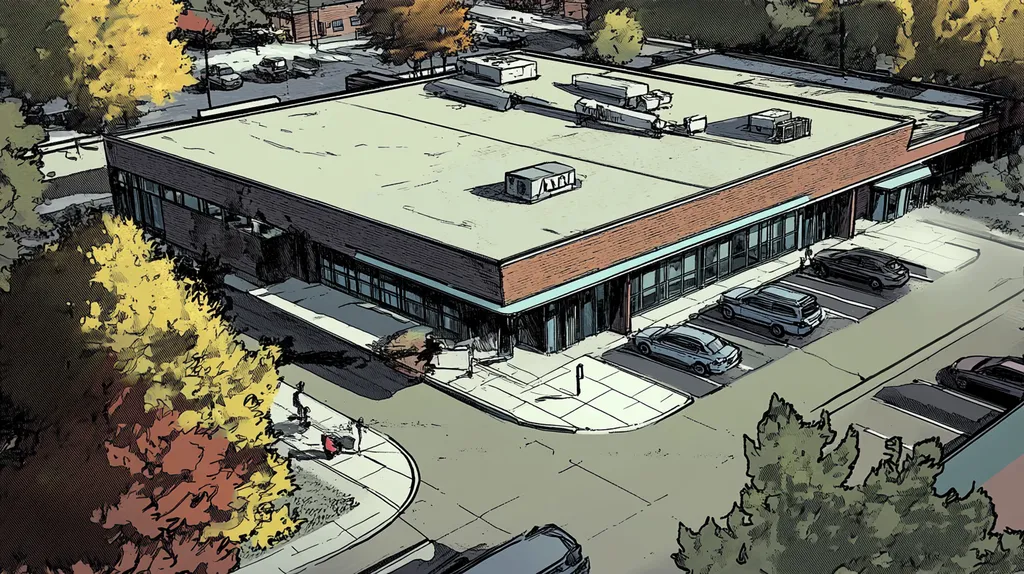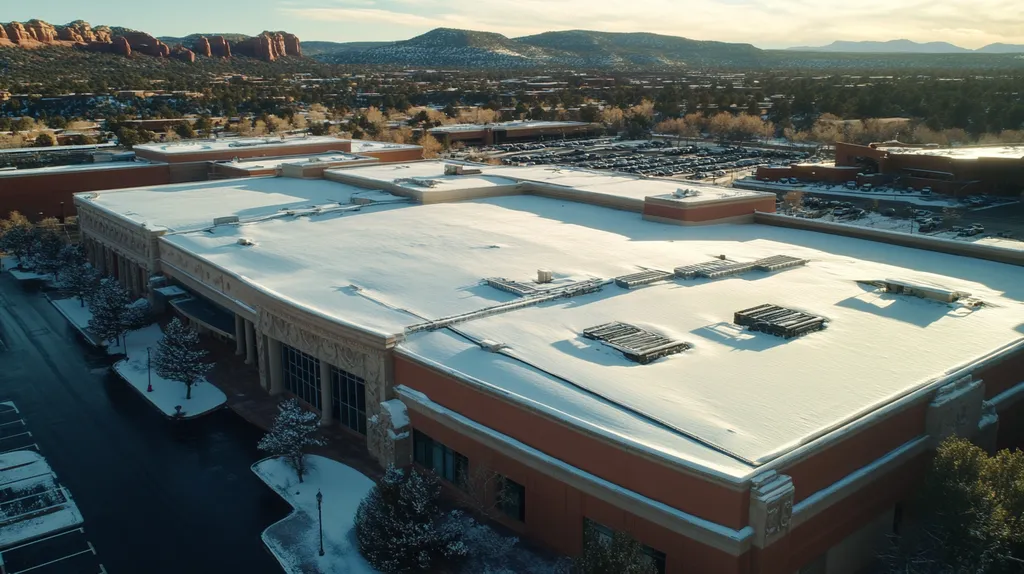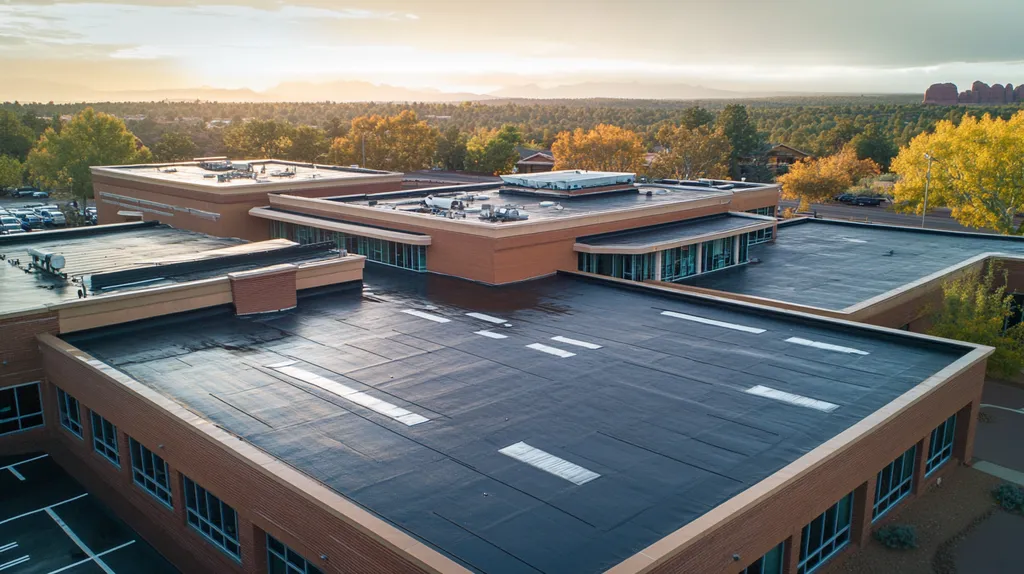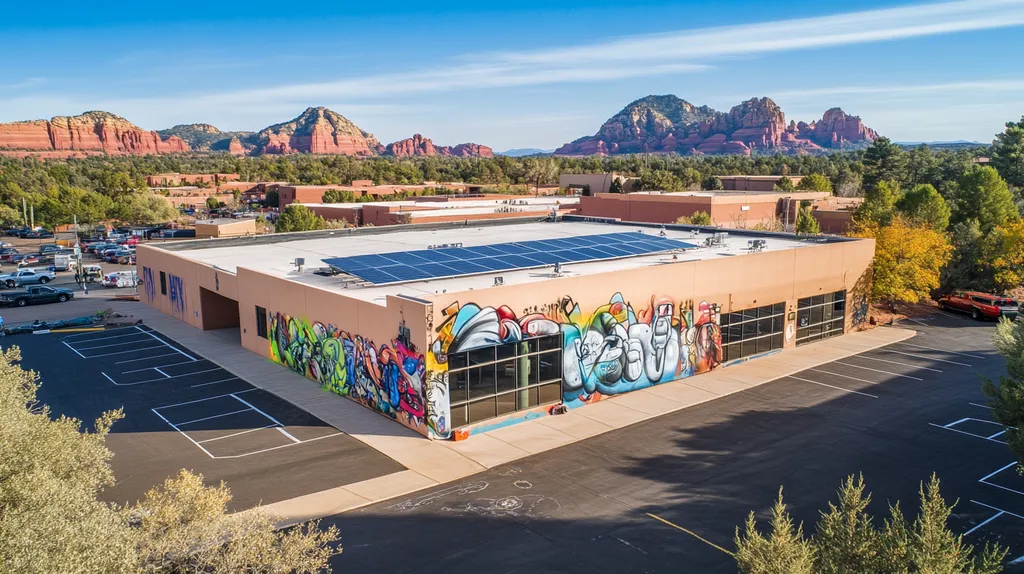In high-humidity regions across America, commercial roofs are failing at an alarming rate, with moisture-related damage accounting for over 40% of all structural failures in commercial buildings.
Traditional roofing materials and installation methods continue to fall short, leading to billions in repair costs and business disruptions annually.
While conventional wisdom promotes standard solutions like basic membrane systems, mounting evidence suggests these approaches are fundamentally flawed for humid environments.
This analysis examines why traditional high-humidity roofing strategies are proving inadequate and explores the critical factors property owners must consider to protect their investments.
SECTION 1: CURRENT PRACTICES
In regions plagued by high humidity, roofing materials face relentless challenges that can lead to significant failures. Traditional options like asphalt and certain metal types often cannot endure the harsh realities of moisture-laden environments. Research indicates that moisture-related problems account for up to 30% of roofing failures, highlighting a critical need for property owners to rethink their material choices.
Common Materials Used in High Humidity
For humid regions, materials such as EPDM (ethylene propylene diene monomer) and TPO (thermoplastic polyolefin) are commonly preferred. These materials stand out for their superior resistance to moisture and degradation from UV rays. Still, improper installation can render even these options vulnerable.
PVC (polyvinyl chloride) is another popular choice, known for its robust waterproofing capabilities. However, its tendency to expand and contract can jeopardize the roof’s integrity over time.
While shingle systems are widely used, asphalt shingles struggle in humid conditions. They have a tendency to trap moisture, which fosters algae growth and accelerates aging.
As we assess the strengths of existing materials, it becomes evident that many may not provide the optimal protection required against continuous moisture exposure.
Installation Methods and Standards
Installation quality is paramount for any roofing system, particularly in humid climates. Conventional practices emphasize the need for sufficient overlap and secure fastening to guard against moisture penetration. Regrettably, many contractors neglect these critical details, significantly increasing leakage risks.
The choice of underlayments also plays a crucial role in moisture management. In humid environments, selecting effective vapor barriers is essential to prevent moisture build-up beneath roofing materials.
Although industry standards continue to evolve, compliance is inconsistent. Property owners must ensure that their contractors not only understand the latest installation techniques but commit to implementing them diligently.
This inconsistency in practices can compromise roof integrity, underscoring the importance of rigorous quality control during installation.
Maintenance and Inspection Practices
Consistent maintenance and inspections are vital for safeguarding commercial roofs in humid climates. Too often, property owners overlook regular evaluations, resulting in unnoticed damage that can escalate over time.
Regular best practices include cleaning debris that can trap moisture and inspecting seams and joints for wear. However, many inspections only consider visible problems, neglecting to assess hidden vulnerabilities that could lead to larger issues.
Proactive steps, such as applying protective coatings, can significantly extend the life of roofing materials. Unfortunately, many property owners remain unaware of these beneficial options.
In summary, poor maintenance habits can accelerate the deterioration of roofing systems, highlighting the urgent need for greater awareness and proactive strategies in high-humidity environments.
SECTION 2: SYSTEMIC ISSUES
High humidity presents urgent challenges for commercial roofs, significantly impacting their performance and lifespan. Many traditional roofing materials simply lack the moisture resistance needed to thrive in these environments, which can lead to rapid degradation. In fact, nearly 30% of commercial roofing problems stem from inadequate moisture management. This section explores the systemic issues associated with conventional high humidity solutions, including moisture resistance limitations, material degradation over time, and the hidden costs linked to frequent repairs.
Moisture Resistance Limitations
Conventional roofing materials, such as standard asphalt and rubber membranes, struggle significantly in high humidity conditions. These materials often absorb moisture, resulting in issues like mold growth and structural weakening. Research indicates that roofs in humid regions can deteriorate up to 50% faster when built with conventional materials.
When moisture seeps in, it creates an environment conducive to leaks and exacerbates existing issues, forcing property owners into a cycle of constant maintenance. This can severely impact operational budgets. To address these risks, it’s essential to consider alternative materials that enhance moisture resistance.
Advanced coatings and synthetic membranes specifically designed for humid climates provide superior protection. These options prevent moisture infiltration and bolster long-term durability against humidity-related damage. Upgrading to these materials not only improves roof performance but also decreases the associated risks that conventional options present.
Ultimately, selecting the right materials is crucial to ensure roofs excel in high humidity. Doing so can lead to substantial time and resource savings over the roof’s lifespan.
Material Degradation Over Time
Even if conventional roofing materials initially perform adequately, prolonged exposure to high humidity typically reveals their vulnerabilities. Degradation can manifest as cracking, peeling, or bubbling—issues that can develop within just a few years if optimal material choices aren’t made.
Taking single-ply membranes as an example, they might function well at first but often show significant wear after continuous moisture exposure. This slow decline can result in severe roof failures, necessitating costly repairs or replacements much sooner than anticipated.
The repercussions of material degradation extend beyond financial strain; they can compromise the building’s overall integrity, impacting insulation and indoor air quality. Therefore, comprehending the limitations of chosen materials is vital to maintain long-term roof performance.
Investing in durable alternatives can dramatically enhance roof longevity, reducing how often repairs are necessary. Making the correct choices from the start is essential for maximizing the lifespan of commercial roofing systems.
Hidden Costs of Frequent Repairs
The ongoing costs tied to frequent roofing repairs can impose a significant financial strain on property owners. While the initial investment in conventional materials might seem economical, the cumulative expenses related to maintenance and repairs can escalate quickly. Properties in humid areas can face repair costs that are up to 40% higher compared to those in drier climates.
Moreover, the time devoted to managing repairs diverts attention from core business operations. The disruptions caused by roofing issues can lead to lost productivity and inconvenience for tenants or employees. Often, property managers must redirect funds from other essential maintenance tasks to address these unexpected challenges.
Choosing superior materials at the outset can help alleviate these ongoing costs. Products designed to endure high humidity not only minimize repair frequency but can also enhance energy efficiency, leading to long-term savings.
Ultimately, recognizing these hidden costs empowers property owners and facility managers to make informed decisions, optimizing roof performance while limiting unanticipated financial burdens.
SECTION 3: MISSED OPPORTUNITIES
In high humidity environments, property owners often overlook substantial opportunities for enhancing energy efficiency, durability, and environmental sustainability. While conventional roofing materials may offer a quick fix, they rarely furnish long-lasting advantages. This oversight can lead to increasing operational costs and maintenance burdens. Understanding the ramifications of these roofing choices is essential for making informed decisions that secure and protect investments.
Overlooking Energy Efficiency
Many commercial buildings in humid climates employ roofing materials that are not designed for energy efficiency. Roofs that retain heat put a strain on cooling systems, driving up air conditioning costs. Conversely, reflective or white roofing membranes significantly mitigate heat absorption and help maintain cooler indoor temperatures.
Research reveals that buildings equipped with reflective roofs can achieve up to 20% savings on cooling expenses. Despite this, property owners often hesitate to adopt these solutions due to misconceptions regarding their performance in humid settings. Prioritizing the right roofing materials can unlock substantial savings over time.
Moreover, energy-efficient roofing options help lower carbon footprints. Reducing reliance on air conditioning not only benefits the environment but also leads to lower electricity bills for commercial properties.
Neglecting energy efficiency is more than just a missed opportunity; it represents a long-term liability that adversely affects the bottom line. Investing in energy-efficient solutions should be a priority, not a consideration for the future when expenses skyrocket.
Neglecting Long-Term Durability
High humidity poses serious challenges for roofing systems, yet many property owners still choose materials lacking the necessary durability. Traditional roofing options typically demand frequent repairs and replacements, creating ongoing financial strain.
For example, asphalt shingles are particularly vulnerable in humid environments and may experience rapid deterioration, resulting in water damage and structural issues. In contrast, advanced materials like thermoplastic polyolefin (TPO) and polyvinyl chloride (PVC) excel in high humidity, providing longevity and reliability.
Investing in more durable roofing materials can prevent disruptive maintenance and save costs in the long run. A robust roof not only shields the building but can also enhance its overall value.
In today’s competitive marketplace, ignoring long-term durability translates into risking significant resources. Ongoing maintenance and replacement can swiftly diminish profit margins, making durability a crucial focus for effective facility management.
Ignoring Environmental Impact
The environmental ramifications of roofing material choices are often underestimated. Conventional roofing materials may emit harmful chemicals during production and installation, affecting both workers and local communities.
Fortunately, high-quality, eco-friendly roofing alternatives exist yet are frequently overlooked. For instance, green roofing systems can substantially reduce stormwater runoff, enhance air quality, and provide insulation, thus representing a sustainable choice.
Additionally, studies indicate that energy-efficient roofs can diminish the urban heat island effect, ultimately benefitting the environment. The collective adoption of eco-friendly materials has the potential to boost urban resilience and improve public health.
Failing to consider the environmental impact of roofing decisions can result in regulatory compliance issues and potential fines down the road. By prioritizing sustainability, property owners not only meet necessary standards but also enhance their reputation in a market that increasingly values green practices.
SECTION 4: ROOT CAUSES
The challenges that commercial roofs face in high humidity climates cannot be ignored; they require urgent attention from property owners and facility managers. Issues such as inadequate material selection, poor ventilation, and a lack of climate-specific design can lead to severe structural damage and costly repairs. According to the National Roofing Contractors Association, roofs that do not properly address humidity concerns are prone to leaks and mold growth, resulting in significant property devaluation. Recognizing these root causes is essential for informed roofing decisions.
Inadequate Material Selection
Choosing the wrong roofing materials is a frequent error in humid environments, with traditional options like asphalt shingles proving particularly inadequate. These materials tend to absorb moisture and deteriorate quickly, heightening risks of mold and structural decline. In contrast, materials like TPO and EPDM membranes are engineered to resist humidity effectively, yet many businesses still settle for standard roofing solutions.
While traditional materials may appear cost-effective at first glance, the long-term repercussions can be financially devastating. Trapped moisture under subpar materials creates conditions ripe for mold and can significantly weaken the roof structure. It’s vital to grasp the unique moisture challenges present in these climates to make informed material choices.
Moreover, inadequate material selection impacts energy efficiency as well. Advanced materials often provide superior insulation, essential for maintaining a comfortable indoor environment. Ignoring this factor can lead to soaring energy costs and a decline in occupant comfort.
In conclusion, making the right choice in roofing materials is a fundamental step in combating the adverse effects of humidity. Organizations must prioritize durability, moisture resistance, and energy efficiency when evaluating their options.
Poor Ventilation and Insulation
Inadequate ventilation and insulation are critical factors that often exacerbate humidity-related problems in commercial buildings. Without a proper ventilation system in place, moisture can accumulate in both the roofing structure and the building interior, leading to a host of issues particularly in humid climates.
Poor insulation compounds the problem, allowing conditioned air to escape and letting humid air infiltrate. This not only compromises energy efficiency but also results in increased utility bills and discomfort for building occupants. Effective ventilation becomes even more critical during the warmer months when humidity levels peak.
Additionally, the absence of sufficient airflow can trap heat in the roofing assembly, accelerating material degradation. Property owners must understand that enhancing both ventilation and insulation is vital for prolonging the lifespan of their roofs.
Ultimately, placing a strong emphasis on proper ventilation and insulation not only mitigates the impacts of high humidity but also improves overall energy efficiency. Investing in these essential elements pays off in the long run, both in terms of cost and structural integrity.
Lack of Climate-Specific Design
Designing roofs without consideration for local climate conditions can lead to severe problems. High humidity necessitates tailored design approaches that recognize moisture levels and weather patterns throughout the year. Unfortunately, many buildings still utilize generic roofing designs that fail to account for these essential local factors.
A climate-specific design includes features like sloped roofs that facilitate efficient water drainage, as opposed to flat roofs that can retain moisture. Incorporating specialized coatings and materials also enhances protection against humidity-related challenges.
The consequences of not adopting these tailored designs can result in an increased susceptibility to water infiltration and accelerated structural wear. Retrofitting poorly designed roofs can be exponentially more expensive than implementing effective designs from the outset.
Recognizing the importance of climate-specific design elements is crucial for optimizing roof performance in humid regions. This proactive approach significantly reduces future risks, ultimately enhancing the longevity and reliability of commercial roofing systems.
DATA DRIVEN EVIDENCE
In the realm of commercial roofing, particularly in high humidity markets, the stakes could not be higher. Studies demonstrate that traditional roofing materials are failing significantly faster than anticipated, leading not only to costly repairs but also to severe structural failures. The data presents a clear trend: conventional materials simply aren’t equipped to handle the persistent moisture that plagues many industrial settings. This section delves into performance metrics, specific case studies of failures, and the often-hidden financial burdens linked to maintenance and replacement.
Performance Data of Conventional Materials
Recent research highlights the alarming degradation of traditional roofing materials, such as EPDM and TPO, in high humidity environments. The National Roofing Contractors Association reports that these materials can suffer a staggering 30% reduction in lifespan compared to their performance in drier climates. Adhesives used in these systems can weaken due to excess moisture, creating further vulnerabilities.
Additionally, manufacturers have observed a decline in crucial performance indicators, including thermal efficiency and waterproof integrity. In zones with high humidity, moisture penetration rates can double, exacerbating insulation problems and affecting underlying structures.
This decline can lead to severe consequences, such as mold growth that compromises not just the roof but also the building’s indoor air quality. Consequently, property owners face the burden of frequent inspections and premature replacements, straining operational budgets and timelines.
Ultimately, these data trends illustrate the pressing need for a reassessment of conventional materials, enabling property owners to make more informed and wise roofing decisions.
Case Studies of Roof Failures
Real-world examples underscore the risks associated with traditional roofing options in humid regions. A notable case involved a manufacturing facility in Florida, where their TPO roof failed after just five years. Moisture seeped in, saturating the insulation layers and resulting in a roof replacement that cost the company over $100,000.
Another significant incident occurred in a Louisiana warehouse, where an EPDM roof buckled under the pressures of high humidity and thermal cycling. The owner suffered not only repair costs but also considerable downtime during the replacement process, affecting productivity.
These cautionary tales serve as critical lessons for facility managers. They reveal the substantial risks associated with inadequate materials and emphasize the necessity for property owners to consider long-term performance and total costs, rather than simply focusing on initial savings.
The accumulating evidence points to a crucial reality: organizations that ignore humidity-specific roofing solutions expose themselves to profound financial and operational risks. The industry is at a crossroads, needing to transition towards materials specifically engineered to thrive in challenging humid conditions.
Cost Analysis of Maintenance and Replacement
The financial consequences of roof maintenance and replacement in humid climates can be staggering. Although traditional materials may seem budget-friendly up front, they often lead to financial distress due to frequent repairs. Reports from the Roofing Institute reveal a near 50% increase in maintenance costs in humid areas compared to drier regions.
Moreover, the costs of replacing a failed roof add an extra layer of financial burden. The average commercial roof replacement in high humidity can exceed $200,000, factoring in labor, materials, and potential damages from leaks.
On the other hand, investing in advanced roofing solutions designed specifically for humid climates might appear more expensive initially. However, these systems typically come with warranties lasting up to 20 years and require far less maintenance—positioning them as a more economical option in the long term.
In summary, a thorough cost analysis highlights the importance of a forward-thinking approach to roofing material selection. Overlooking the unique challenges posed by humidity is not merely a technical oversight; it’s a risky financial gamble that property owners cannot afford to ignore.
SECTION 6: ALTERNATIVE SOLUTIONS
As the effects of climate change become increasingly pronounced, the stakes for commercial roofing in high humidity regions have never been higher. Conventional materials frequently succumb to relentless moisture, resulting in structural damage and mounting maintenance costs. Property owners must urgently explore alternative solutions that enhance the longevity and performance of their roofs. Innovative materials such as metal and TPO roofing, along with EPDM and green roofs, represent viable options. Furthermore, advancements in ventilation and insulation techniques promise to mitigate moisture-related challenges.
Metal and TPO Roofing Advantages
Metal roofing stands out as a top choice for high-humidity environments due to its unmatched durability and moisture resistance. Unlike traditional options, metal roofs do not absorb water, significantly lowering the chances of mold growth and corrosion. Additionally, they reflect sunlight, which helps maintain cooler indoor temperatures and can decrease cooling expenses.
Thermoplastic Olefin (TPO) is another innovative solution gaining traction. This single-ply roofing membrane is engineered to withstand harsh weather conditions, including high humidity. TPO roofing boasts excellent UV and chemical resistance, extending its lifespan considerably.
The straightforward installation process of TPO allows for rapid application, minimizing disruption to business operations. Its energy efficiency further aids commercial properties in humidity-heavy climates, where controlling heat absorption is essential.
Both metal and TPO roofing provide long-term benefits that can significantly alleviate the negative impacts of high humidity, making them excellent choices for commercial roofs.
Benefits of EPDM and Green Roofs
Ethylene Propylene Diene Monomer (EPDM) is a resilient single-ply roofing membrane particularly suited for high humidity environments. Its flexibility enables it to account for temperature fluctuations without cracking—an issue that rigid materials often face. EPDM’s moisture resistance makes it ideal for buildings situated in wet climates.
Moreover, green roofs are gaining popularity, not only for their environmental benefits but also for their functional advantages. These living roofs help reduce stormwater runoff while improving air quality by filtering pollutants. The vegetation provides additional insulation, lowering energy costs in both summer and winter.
Integrating green roofing systems can also boost the aesthetic appeal of commercial properties. This enhancement often results in improved occupant satisfaction and may even elevate property values.
Both EPDM and green roofs present distinctive features that directly address the challenges posed by high humidity, offering property owners sustainable and effective alternatives.
Innovative Ventilation and Insulation Techniques
Innovative ventilation and insulation techniques are critical in maintaining the integrity of commercial roofs amidst high humidity. Effective ventilation regulates temperature and minimizes condensation, which can lead to rust and mold issues.
By installing ridge vents and exhaust fans, warm, moist air can be expelled from the roof space. This strategic approach is essential for preventing moisture buildup, especially in attics and sealed areas.
On the insulation front, advanced materials like spray foam can create robust barriers against moisture infiltration. By sealing gaps and cracks, spray foam insulation aids in maintaining even indoor temperatures while effectively lowering energy costs.
Implementing these cutting-edge techniques enhances the performance of both traditional and modern roofing materials, ensuring durability and longevity in the harsh conditions of high humidity.
The Bottom Line
With over $12 billion lost annually to moisture-related commercial roof damage, the industry stands at a critical crossroads.
Traditional roofing materials continue failing at unprecedented rates in high-humidity environments, with 40% of these failures occurring within the first five years of installation.
The data clearly demonstrates that conventional solutions are fundamentally inadequate for modern climate challenges, leading to accelerated deterioration, skyrocketing maintenance costs, and compromised building integrity.
Forward-thinking property owners must embrace innovative materials like TPO and advanced ventilation systems, or risk facing ever-increasing repair costs and potential structural failures.
The evidence is clear: adapting to humidity-specific roofing solutions isn’t just an option – it’s an urgent necessity for protecting commercial investments in today’s changing climate.
FREQUENTLY ASKED QUESTIONS
Q. Why do traditional commercial roofs fail in high humidity?
A. Traditional roofing materials like asphalt and certain metals cannot withstand moisture. Their inability to resist high humidity leads to problems like mold growth and structural weakening, resulting in significant failure rates.
Q. How does moisture resistance affect industrial roofs?
A. A lack of moisture resistance in roofing materials can lead to rapid degradation, affecting lifespan and performance. This results in costly repairs and can impair the structural integrity of the entire building over time.
Q. What energy-efficient materials are good for commercial roofs?
A. Energy-efficient materials, such as reflective TPO and green roofing systems, help lower cooling costs and improve indoor comfort. These materials minimize heat absorption, making them ideal for humid climates by enhancing overall energy efficiency.
Q. Why is proper installation crucial for commercial roofs?
A. Proper installation ensures that roofing systems can resist moisture and avoid leaks. Neglecting installation details can significantly increase leakage risks, compromising the roof’s durability and functionality in high humidity environments.
Q. What are the long-term benefits of using durable roofing materials?
A. Durable roofing materials can significantly extend a roof’s lifespan, reducing maintenance frequency and costs. Investing in sturdy options leads to fewer disruptions in operations and enhances overall property value.
Q. How can ventilation impact commercial roofs in humid climates?
A. Adequate ventilation regulates temperature and reduces moisture buildup, minimizing risks of mold and structural damage. Improving airflow within the roofing assembly is essential for maintaining integrity and prolonging the lifespan of the system.
Q. What additional factors should I consider for my commercial roof?
A. Consider environmental impact, maintenance protocols, and local climate when selecting materials. Prioritizing sustainable solutions can improve energy efficiency and meet compliance regulations, while ensuring long-term performance.

